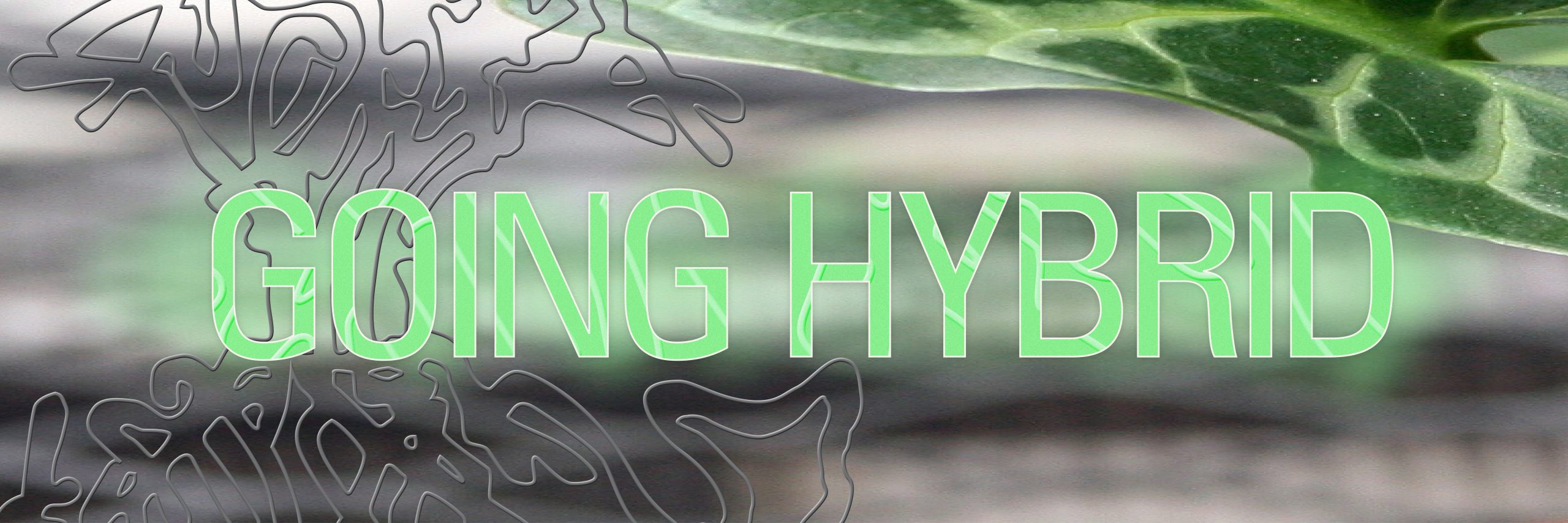We are sitting in Spui25’s brightly lit room, preparing to dwell on Practices of Streaming Resistance. Following a brief introduction, we welcome Karl and Margarita from The Hmm and Hackers & Designers on stage
Margarita Osipian (The Hmm) and Karl Moubarak (Hackers & Designers)
Margarita Osipian is an independent curator, researcher, and cultural organizer based in Amsterdam. Engaging with the intersections and socio-political frictions within art, design, and technology, she organizes workshops, exhibitions, and collaborative projects both in formal institutions and in more precarious and ephemeral spaces. Holding an MA in Media Studies from the University of Amsterdam and an MA in English Literature from the University of Toronto, her research has focused on visual culture, technology, and the carceral state. Margarita is part of The Hmm, a platform for internet cultures, on the curatorial team of Sonic Acts, and part of the artistic core of the W139.
Karl Moubarak is a designer, researcher, and web developer whose practice is rooted in the digital sphere and focuses on the development of on- and offline sites for connectivity and exchange. He is a member of the Amsterdam-based workshop cooperative Hackers & Designers (2019–ongoing), Eindhoven-based interstitial collective body Office of Queer Affairs (2017–ongoing), and Beirut-based historical oral archiving initiative OH4L (2020–ongoing). Karl works on projects that aim to make visible the processes, tools, and mechanisms that co-constitute them, and generates experimental methods of liveness and dissemination, as facilitated by the sensitivities of free, libre, and open-source software.
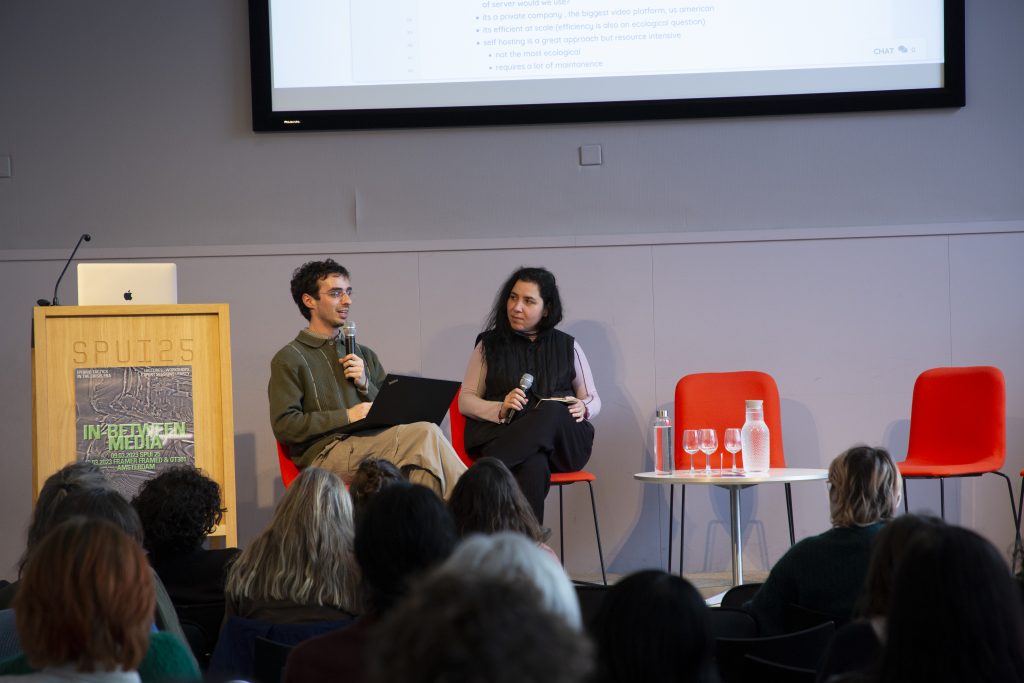
Their discussion on Thresholds of Access opens with them briefly describing their appearances for the members of the audience, on and offline, who are not able to follow the discussion visually, therefore establishing new points of access. First, they focus on the history of The Hmm live stream. The Hmm live stream started from an online lecture on live streaming in the beginning of the pandemic. (The code for it is available on GitHub here: https://github.com/hackersanddesigners/the-hmm-livestream). This code has been used by a few organizations such as Sonic Acts, Het Nieuwe Instituut. For a while The Hmm has been focusing on bringing the digital into the physical, implementing hybridity in their live streams. One such example is their exhibition BodyBuilding: Inefficient Tool Building for Quantified Beings (Hackers & Designers). It can be found here bodybuilding.hackersanddesigners.nl.
We follow Margarita and Karl as they walk us through The Hmm’s playful live-stream archive. They emphasize that they wanted to experiment instead of just theorizing, which reflected in the design decisions: a bubbly and fun website in bright primary colors. They show small and fun additions to the user interface, which translate the presence of people online through little dots that explode in emotes once a user reacts to the stream. The Hmm is actively pursuing the idea of lighter internet for more sustainable data exchange. Not everyone has the access to watch the live-stream, as the bandwidth required to watch a live stream is really high. To forego this The Hmm live stream has different modes of accessibility such as sound-only, low-low-res and etc.
The only information stored on The Hmm website is the username one selects, mostly required to leave live comments. One can specify what amount of time the username should be stored. Nothing is deleted unless so requested.
Karl and Margarita also talk about the choices that were made in the process of creating The Hmm live stream platform. An important technical detail is that they use the live stream provider Mux. There is a tutorial available for it, which they used themselves: https://docs.mux.com/guides/video/start-live-streaming. Since Mux is a big tech company, there is no author on the tutorial, so they could not cite them. One of the features they implemented was to show online the data transfer information. It is complicated to showcase data sent/received on the website because it is not something conventionally used in the front end. Karl referred to it as a “hacky” approach. The question arose of who is responsible for these web conventions. How does one actively change the default settings, when they are not as easily accessible?
The tensions between accessibility and open source became apparent to Karl and Margarita as they were developing a live stream platform for The Hmm. Once they tried to implement live captioning it was as if “opening a can of worms”. While giving preferences to open source, it was not possible to do so for live captioning. Not everyone sees the importance of self-hosting, Karl highlights. The top choices for streaming hosts are still google and mux. One of the biggest issues with live captioning is the censorship of language and the low quality. Mux is much more flexible. Many live captioning plug-ins were developed under proprietary large-scale institutions / capitalist companies. The Hmm chose not to self-host due to time and resource constraints.
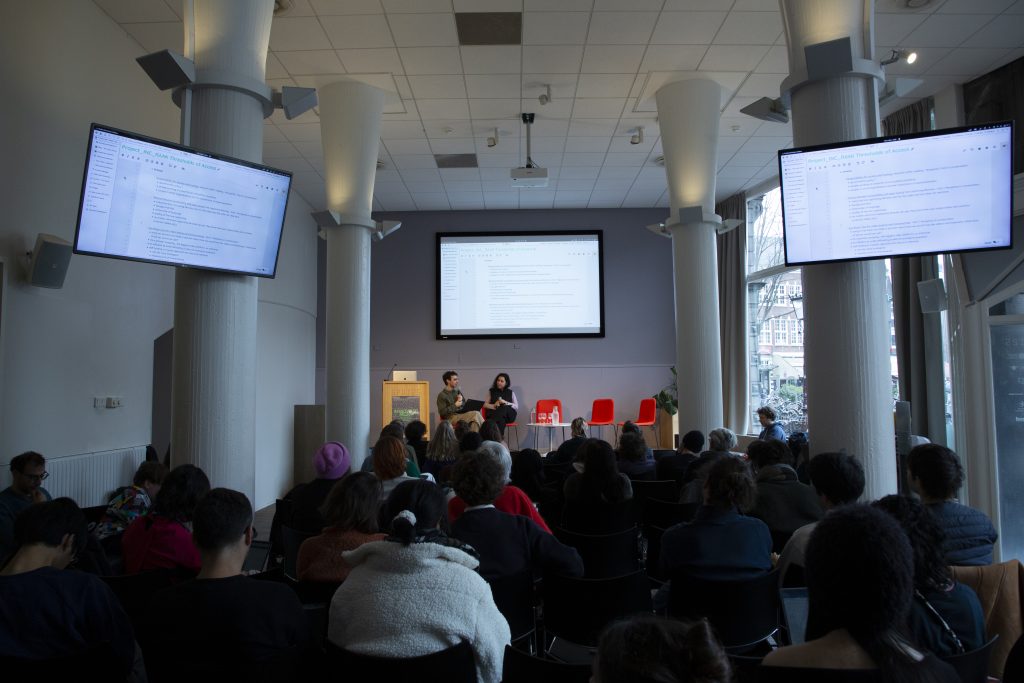
The presenters giggle. The atmosphere is warm and informal, as they clumsily navigate numerous windows in the browser. Etherpad, websites, The Hmm, and more.
What are the standards for accessibility? There are “lots of them”. But as Karl concludes siting disability and crip theory, standards are ableist, as they reinforce certain structures. According to Against Access by John Lee Clark https://audio.mcsweeneys.net/transcripts/against_access.html
Karl underlines the situatedness of The Hmm, the specific context it exists in, has defined the choices made. They are in no way trying to propose a solution.
Karl and Margarita round up their discussion by citing collaborators of The Hmm live stream. Designer Anja Groten, Toni Breil, Jon Kyle, and more.
Digital Infrastructure Resilience and Weaponized Design – A Presentation by Cade Diehm
The second presenter, Cade Diehm walks on stage. Cade Diehm is the founder of The New Design Congress, an international research organization forging a nuanced understanding of technology’s role as a social, political, and environmental accelerant. He studies, writes, consults, and speaks regularly on topics such as digital power structures, privacy, information warfare, resilience, internet economies, and the digitization of cities. He stands on a beer crate to reach the microphone. His presentation on Digital Infrastructure Resilience and Weaponized Design in a fun and joking manner, establishing a welcoming atmosphere, a beautiful break from the “doomy feeling” that is so present in academia. He states that he came here with “cynicism and impatience”, an emotional reality of many media researchers.
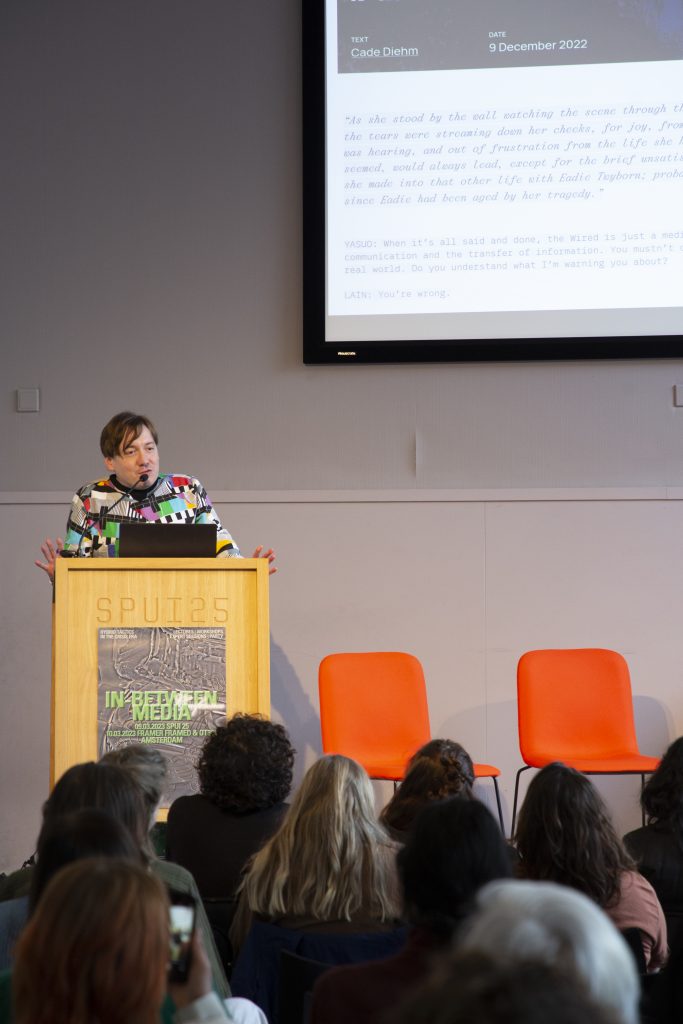
Cade opens his presentation with a series of videos, provocations, as he calls them. One of them is a TikTok depicting, what appears to be cis-het men in construction work, reacting to the infamous TikTok girl filter. He brings up the idea of cracking, one might even say hacking, oneself by trying a gender different to one assigned at birth (for example through feminizing TikTok filters). Cade himself identifies as a cisman and consciously addresses his position within the discourse.
There is a definite appeal of “identity voyeurism”, a term coined within early cyberfeminist discourse, for “red pilling” those stuck in the trenches of white cishetero patriarchy. Through witty remarks and references to theory, Cade weaves in provocative content. He shows a video titled “inexpensive video conferencing lighting solutions”. Then he moves on to Gamergate, (specifically its “actually” logo), a misogynistic online harassment campaign, navigating his presentation into a new direction. Cade talks about Gamergate and how “apolitical teenagers were groomed into far right” belief systems by video games. He meditates on the idea of hijacking gaming to infiltrate apolitical spaces, and how that could potentially be used in reverse. Cade draws multiple parallels with trans experiences, by using red pilling, enlightenment, and exposing one to the real. We are introduced to his piece of writing “The Para-Real: a manifesto” is taking. (The Para-Real: a manifesto can be found here https://newdesigncongress.org/en/pub/the-para-real-manifesto at newdesigncongress.org.). Para-real is the opposite of what he states. The Para-real exists separately. Cade jumps between theory and witty provocations (sometimes clumsily so). We have not even realized, but we are now watching a TikTok of a child playing Roblox. Within Roblox, this child created a large-scale scamming scheme. (They even have an intern Kate helping them scam people).
Disillusionment about tactical media. Cade moves into provocation, yet again. How can we escape this grid? An interesting point that he brings up: there is a systemic issue, as we are evaluating platforms, we are technically evaluating the past. As software updates shed one after another, our work is reactional. By the time research reaches the masses it is no longer representational of the present. This as a result makes me think of the urgency of media research and hybrid publishing, one of the central themes of the conference.
Cade brings an unexpected twist. Many people in the audience are laughing, and some are confused, as furry content takes over the screens. Cade talks about Furries being at the frontier of radical care. Some Furry VR festivals, such as VirtualFurence, Furality and etc, are presented as antidotes to extractivist platform use. Furries have shown each other real economic solidarity during the first lockdowns.
UKRAiNATV, or: Introduction to Stream Art, Hybrid Togetherness and Virtual Politics – by Roman Dziadkiewicz
The weirdness does not stop here. As Roman Dziadkiewicz walks upon the stage. He is here to represent UKRAiNATV, alongside two other people, Julia and Ksenia, who are present in the audience. Roman defines himself as a multisensory artist, researcher, activist, songwriter, and occasional artist-curator. Engaged in long-term studies, interdisciplinary, intercensal projects, projects, actions, workshop strategies, graphic design, and text-based projects, and also collective activities on the border of art, social and educational spheres. His interests are particularly oriented around the question of challenging and disintegrating the artwork, correlations between daily life, cultural/ritual contexts, texts (narrations, history, stories), and politics/publicness.
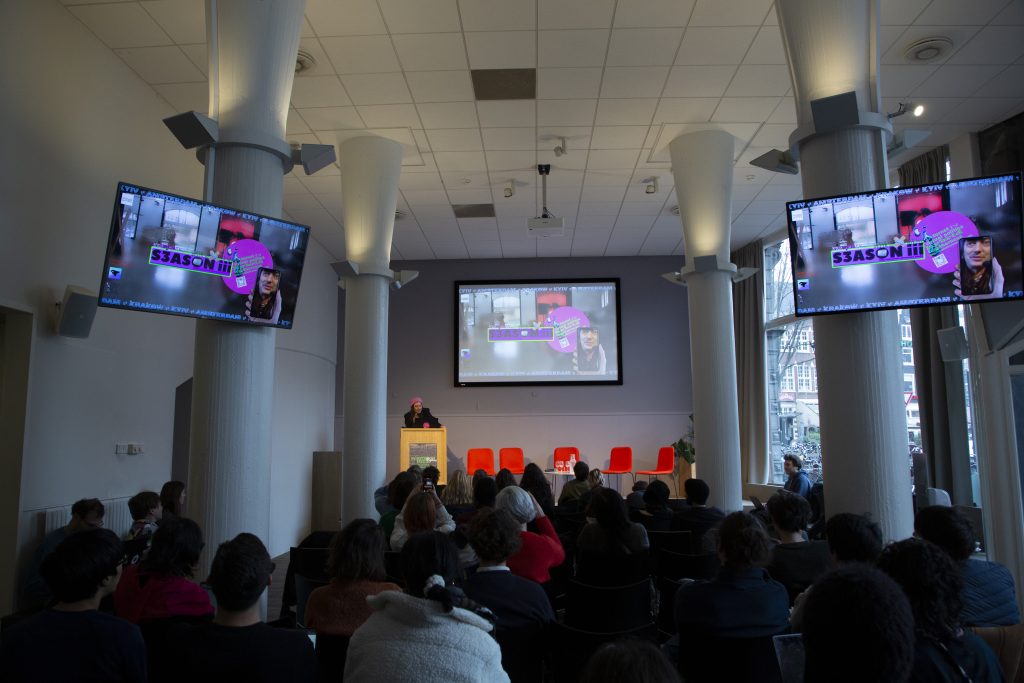
In his presentation, he introduces the idea of Stream Art, Hybrid togetherness. Roman being present on stage, is like a fever dream, an explosion of neon pink, flashes of lime green and purple chrome. Roman is dressed in a pair of memorable patchwork trousers, made out of a combination of pink, white, and red plush furry fabric, a black blazer, and a pink beanie. His overall look matches the aesthetic of UKRAiNATV, bright, bold, and positively chaotic. He starts his presentation with a “little show”. On the big screen, we can see UKRAiNATV visuals surrounding a mock-up of an iPhone with the live stream of Roman in it, that is being sent from his laptop camera. The presentation morphs from 3D graphics, into past recordings of performances, DJ sets, and interviews in a precariously macabre way. Roman highlights the importance of technical knowledge (“learning how to, because we need knowledge”) in this crisis era. Techno starts to play, and the image of Gleb Dovzhuk emerges on screen through the pink fog of overlays, like a specter on an acid trip. Gleb Dovzhuk moved to Poland from Ukraine a few years ago and has been a prominent figure in the formation of UKRAiNATV.
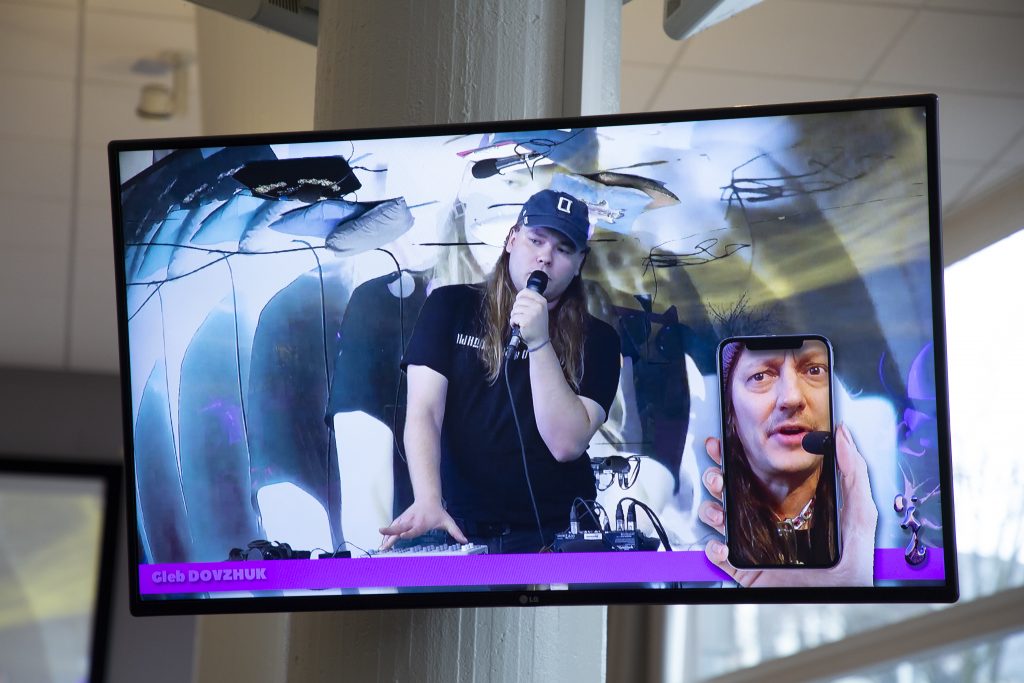
Since UKRAiNATV started a year ago, it has become a refuge from the stresses of war in Ukraine and other crises. UKRAiNATV became a safe space for people to hang out, dance, create art, perform, and connect through the stream to people who are not physically present in the room. (techno playing in the background) There are two elements of the UKRAiNATV, the two legs as Roman calls them: the stream and art studio. #StreamArtStudio. It is not human, hybrid, posthuman, or transhuman. The screen lights up with the hashtag streamArtStudio. UKRAiNATV’s live streams become a live circulation of visuals, music, performers, humans, bodies, and a whirlwind of data. Roman refers to it as Stream Art. He shows a drawn diagram, that visualizes a circular relationship between Data, People, and Machines. Machines: cameras, wires, computers, microphones, lights. In this whirlwind, people merge and (contrast) the visual (images). A horizontal, non-hierarchical circulation. “Pictures, pictures, pictures”.
Since the invasion of Russia in Ukraine, the studio switched to a new chapter. Apart from virtual production and 3D playground it also became a safe space for real people, people who need to be in touch with other people, such as refugees. The first stream happened on 04.03.2022. As the war started, the urgency to create something that could connect people in a way that is elevating was born. UKRAiNATV use platforms such as twitch etc to host their content. (This choice is to be available??)
Roman goes on what he calls “trips in mythology”, looking into birth and rebirth cycles “bios – thanatos – bios”, the etymology of the word “efir”, coming from the ether. What does hybridity mean? Hubris, a fault. Non-human?
Roman takes into consideration the position of the “player” in the live stream. He talks about the live act and VR chats. Collaborative multiplayer experience. odyssey – restream – www – twitch – vrChat – fb – yt platform dependencies. He talks about the multidimensional constructional structures, both virtually (platform interconnectedness, and platform attachment) and physically, as in the studio setup. “Very hybrid set up” as he calls it, with its streaming tools, computers, software, and cameras.
UKRAiNATV links people in dynamic situations. Being in movement. A collaborative multiplayer experience.
Round table with Cade Diehm, Roman Dziadkiewicz, and Karl Moubarak, Moderated by Margarita Osipian
Roman’s presentation was followed by a round table featuring the speakers, moderated by Margarita Osipian. They were given 20 minutes to discuss some of the common issues and questions that arose during the presentations. There is an informal atmosphere in the space. The first question from Margarita, fascinated by furries, was addressed to Cade. He expands, by first talking about the “tyranny of time” and the “psychopathy and body horror” of being seen only as data points, disembodied sources of information. VR chats are rectifying the notion of embodiment. That is a pathological horror against the human body. A documentary he gives as an example is “We Met in Virtual Reality” (2022) which was bought by HBO. It was entirely filmed in VR and is a perfect example of community building in Virtual Spaces. As mentioned by one of the characters/people, VR chats save people’s lives, it is what gets them out of bed in the morning. “Helping Hands” sign language community in VR chat, where participants can learn ASL.
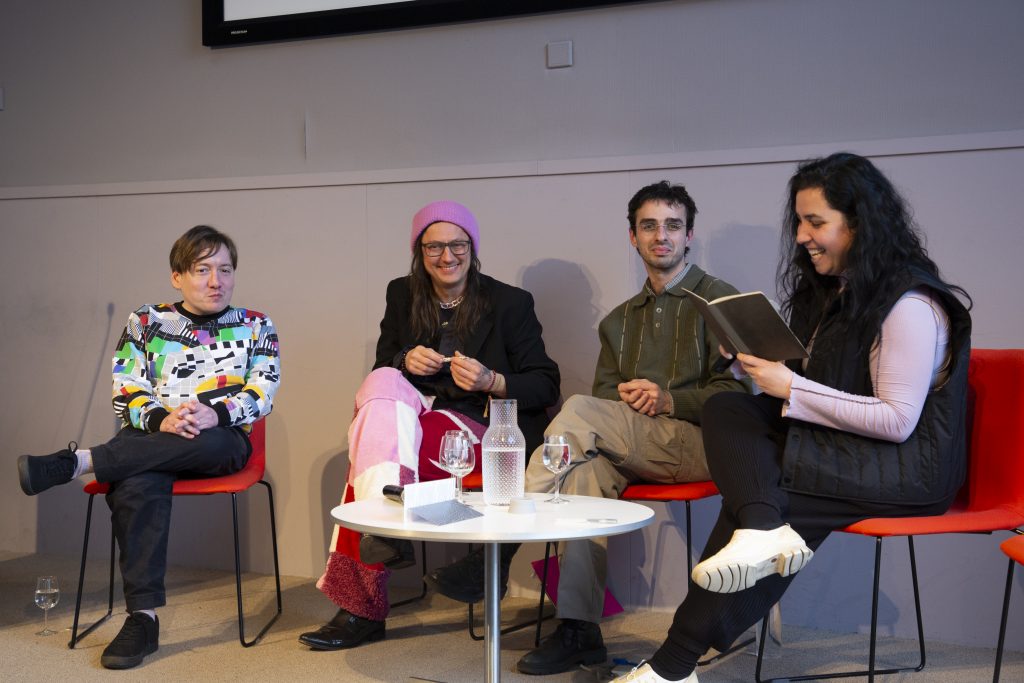
The question of accessibility that was earlier posed by Karl surfaces again, and Margarita asked about Karl’s and Roman’s tool choices for their live streams. Roman underlines the importance of platforms in UKRAiNATV’s streaming process, as they allow the need to be present everywhere, the ease of access. There is a need for alternatives in the “crisis of narration”, more narratives should be accessible to people through platforms and outside of them. As he says “platforms become useful in war”, yet there is an issue of platform mobility and content independence. Cade poses a question to Karl: “With DIY tools quality generally declines. How was it seeing the success of building your own platform?” “So deeply stressful” Karl replies laughing. It is a relief. Karl and Margarita say “chaos is fun”, and that The Hmm live stream has been somewhat curated for an audience that loves and appreciates chaos and experiments. Roman steps into the conversation with his remark on “the importance of joy in the crisis”. Dance and have fun. Karl remarks: “I woke up this morning with this doomy feeling which is so common in Academia, but now I feel much lighter and more joyful. #HopeCore.”.


